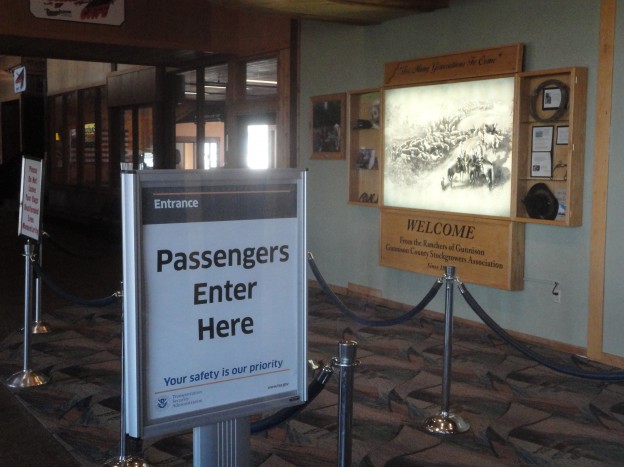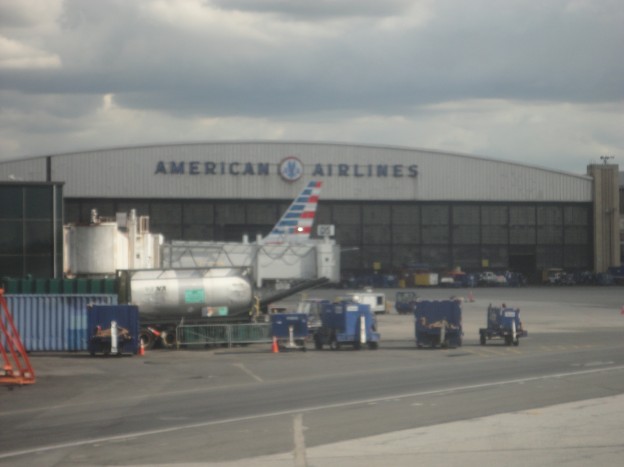Colorado’s Flights Fight
Flying Directly to Small Colorado towns is Limited
Colorado’s Flights Fight as illustrated in a Denver Post Article Titled Colorado’s Fight for Flights is a story of limited small Colorado community air access. It’s a You can’t get there from here situation. It’s a phrase that could hamper economic development efforts across Colorado. Without a corporate jet or a charter flight, business travelers and tourists alike could be facing a more difficult time flying to many of Colorado’s smaller communities. Colorado’s Flights Fight is about Colorado Communities efforts to sustain and/or grow air service.
http://www.bizjournals.com/denver/print-edition/2014/02/07/cover-story-colorados-fight-for.html?iana=ind_travel&page=2 – Link to Story in Denver Business Journal
L. Wayne Hicks
Associate Editor- Denver Business Journal
David Gordon, director of CDOT’s Division of Aeronautics, says, “It helps the state’s economy as a whole to have a good system of airports.”
Dramatic changes to aviation have many Colorado communities struggling to revive or restore airline service to their towns — a key factor that can make or break local economic development efforts.
Flight cutbacks by some airlines, even abandonment of air service to some local communities in recent years, threaten to undermine the efficiency of the entire state’s air service system.
Barring use of a corporate jet or a charter flight, vast expanses of Colorado can only be reached by a long drive. And increasingly, airlines are finding some small towns too expensive to serve without costly subsidies from those communities.
Passenger numbers are down at most of Colorado’s regional airports since 2008. If that trend continues, airlines will likely reconsider flying those routes — and communities will have to dig deep for subsidies and incentives to keep them.
A lack of commercial air service can hurt a region’s economic development chances. Companies may shy away from moving into parts of Colorado that don’t have regularly scheduled flights. And out-of-state tourists may steer clear of Colorado’s ski resorts without an easy way to get there.
“A lot of those airports not only serve the local community but serve traffic in and out of DIA,” said David Gordon, director of CDOT’s Division of Aeronautics. “It’s important to have a feeder system going into DIA. It helps the state’s economy as a whole to have a good system of airports.”
Colorado has 13 airports with scheduled passenger service. That’s down from 14 when the Fort Collins-Loveland Municipal Airport lost its only airline — Allegiant Air — in October 2012. And the small community of Lamar (population: about 7,800), about 100 miles east of Pueblo, saw its commercial service vanish in 2000 after the federal government determined the price to subsidize flights there had become too expensive.
“You do hear from people who wish they could fly up to Denver,” said Lance Benninghoff, executive economic director for Prowers County Development Inc. in Lamar. But, he said, Lamar and the surrounding county doesn’t have a population large enough to support commercial airline service.
For communities across the state, air service provides too big an economic boost to let passenger service slip away, so they’re offering subsidies and other perks to airlines. The city of Aspen considers service at its airport “an essential driver for the Roaring Fork Valley’s overall economic health and viability,” according to its city council.
“It’s probably one of the most critical things for a region or a town to have, to have an airport with commercial service,” said Dave Ruppel, manager of the Yampa Valley Regional Airport in Hayden, near Steamboat Springs.
The Colorado Department of Transportation last year estimated the economic impact of the state’s airports is $36.7 billion, once jobs, payroll, air cargo and other factors are counted. DIA accounts for the biggest share of that, at an estimated $26.3 billion, and triple the amount attributed to Colorado’s other commercial airports combined.
“The CDOT study gives people a snapshot of the importance of the airports,” said Travis Vallin, a principal of Jviation Inc., a Denver-based aviation consulting firm. Vallin, who previously was head of CDOT’s Division of Aeronautics, said the airports are “critically important … to the economics of the state.”
DIA enjoys what Colorado’s other commercial airports don’t: a steady stream of about 2 million travelers monthly, and the presence of 17 airlines. But even DIA isn’t immune from the changes that have torn through the aviation industry. After passenger counts that climbed to a record 27 million in 2011, DIA has seen the numbers remain relatively flat since then.
Offering incentives
So what can Colorado’s smaller communities with commercial airports offer to stay on the radar screen of the airlines? Money.
Whether in the form of revenue guarantees or marketing support, the airlines are receiving financial help from many of the towns they serve. The incentives are meant to reduce the economic risk an airline takes when starting a route.
“Airlines are pretty risk-averse,” said Scott Stewart of Community Flights, a Telluride-based aviation consulting firm, “and if they see there is a risk they’re going to look to get into a risk-sharing agreement in many cases.”
Stewart started his firm at the end of 2012, after stepping down as executive director of the Telluride Montrose Regional Air Organization. Now known as Colorado Flights Alliance, the organization works to attract and retain service at the Montrose and Telluride airports.
Backed by the city of Montrose, Telluride Ski Co., business contributions and a 2 percent tax on food and lodging, Colorado Flights Alliance spends about $3 million annually on revenue guarantees.
With a revenue guarantee in place, airlines won’t lose money on a route. Communities have to pay up only if the revenue a route generates falls short of a pre-determined amount.
Steamboat Springs, which relies on the Yampa Valley Regional Airport, would see fewer flights without funds raised by a special taxing district, said Lisa Sanchez Warner, a member of the Steamboat Springs Local Marketing District. The district collects a 1 percent tax on lodging and that money, she said, “primarily goes to pay the airlines to come here.”
Steamboat Springs voters approved a quarter-cent increase in the city sales tax in 2011, with those funds earmarked specifically to attract winter service to the airport. “We have a small community here and our economy is tourist-based, so we need to get our tourists here in the winter season,” Warner said.
Eagle Air Alliance, a group of businesses and local governments in the Vail Valley, offered United Airlines a $500,000 revenue guarantee last year for a summer flight from Houston to the Eagle County Airport, near Vail.
“One of the major challenges we have compared to other destinations like Telluride or Crested Butte is that all of those other resort areas have a permanent dedicated funding source,” said Chris Romer, president and CEO of the Vail Valley Partnership, which oversees the Eagle Air Alliance. “They have a regional transit authority or a local marketing district that allows them to collect, often times, tax money for a revenue guarantee. We go out and raise money. We raise money every single year using the tin cup model. We shake the tin cup at a business and say, ‘We’re working to increase flight service but we need you to pledge and to commit’.”
Romer said it takes about three years for a new route to stop needing a revenue guarantee. That’s how long it takes a new route to sustain itself.
The Eagle Air Alliance, which only has enough funding for one revenue guarantee program a year, can then turn to that money to attract new flights, Romer said.
The Aspen/Pitkin County Airport doesn’t offer revenue guarantees. “If the airline’s making enough money here, they stay,” said Jim Elwood, airport director. “If they don’t, they move on.”
But the Aspen airport does make funds available to market a new service, as was the case in advance of Delta Air Lines offering winter flights from Atlanta and Minneapolis. Aspen, Pitkin County, the Town of Snowmass, Aspen Skiing Co. and the Aspen Chamber Resort Association all donated.
“We purchased some space on their gate monitors in Atlanta and other places, some other points of contact with their customers that let them know about the flight into Aspen,” Elwood said.
The Delta flights are expected to bring in about 5,232 visitors this winter, with a potential economic impact of $7.8 million to the region. Pitkin County commissioners, who approved a $50,000 contribution, estimated a direct impact to the county would be $67,493.
The Aspen airport, which at $707.27 has the highest average one-way fare in Colorado, benefits from its proximity to the Aspen Mountain and Snowmass ski areas.
Stewart, whose clients include the Crested Butte Mountain Resort, said a community is more likely to attract visitors if an airport is relatively close. “People don’t want to fly into a Denver or an Albuquerque or some other airport and then have to do a lot of driving to get to their final destination,” he said. “They’ll go instead to Salt Lake City and go skiing there or they’ll go to some other place where the airport is more convenient to the final destination.”
There’s more at stake than tourism dollars. The DOT allocates $1 million a year to airport that attract at least 10,000 passengers annually, with that money available for such expenses as terminal or runway improvements. Drop below that number, the amount of federal money available falls to $150,000.
And businesses looking to relocate or expand these days want to be within 60 minutes of an international airport, said Tom Clark, CEO of the Metro Denver Economic Development Corp. He said that’s the No. 1 criteria companies consider.
“It’s just a pivotal piece of an economic strategy,” Clark said. “For cities that don’t have it, it’s a challenge.”
Dan Tate, executive director of Southeast Colorado Enterprise Development Inc. in Lamar, which has an airport but no scheduled flights, said the lack of air service “is definitely not positive. From an economic development point, it’s a negative to not have that service. We’ve had such an out-migration of companies for one reason or another; some of that is due to logistics. But commuter service doesn’t seem to be a priority at this time. We’re just trying to hang onto the jobs that we currently have.”
Douglas Dowler, executive director of Southern Colorado Economic Development District in Pueblo, which does have air service, said the availability of passenger flights “certainly makes you more attractive when you’re talking to businesses willing to relocate to the area. One of the key questions is, of course, access, especially when you have companies that have multiple locations, not only in our state but in other states. The ability to fly and travel between those locations is crucial.”
Jack Rink, president and CEO of the Pueblo Economic Development Corp., agreed that business prospects consider air service when scouting the area.
“It’s on their checklist,” he said. “One of the questions they ask is is there a local airport and do you have air service? The answer is yes. We have it from Pueblo to DIA, and as backup we’re 45 minutes from Colorado Springs, and that satisfies everybody.
“That said, we’re still working hard to get more flights out of Pueblo and hopefully to some other hubs beyond just DIA,” Rink said. “It’s a challenge, because everyone knows the state of the airline industry.”
L. Wayne Hicks is associate editor of the Denver Business Journal, writes the “Cultural Attache” blog, and compiles the daily “Morning Edition” email. Phone: 303-803-9221.
Colorado’s Flights Fight story above, illustrates the challenges Colorado’s attractive tourism communities have in acquiring and sustaining air service. These challenges persist even when revenue guarantee and other incentive programs are present.
There is a lot right about the many efforts in Colorado to support Colorado’s Flights Fight. The fact that many communities have organized air service attraction and support programs is a great start to meeting the challenges of sustaining air service. While Colorado’s Flights Fight is certainly not unique to the state, we personally feel that Colorado’s Flights Fight is one that can be one by many of the Colorado communities.








